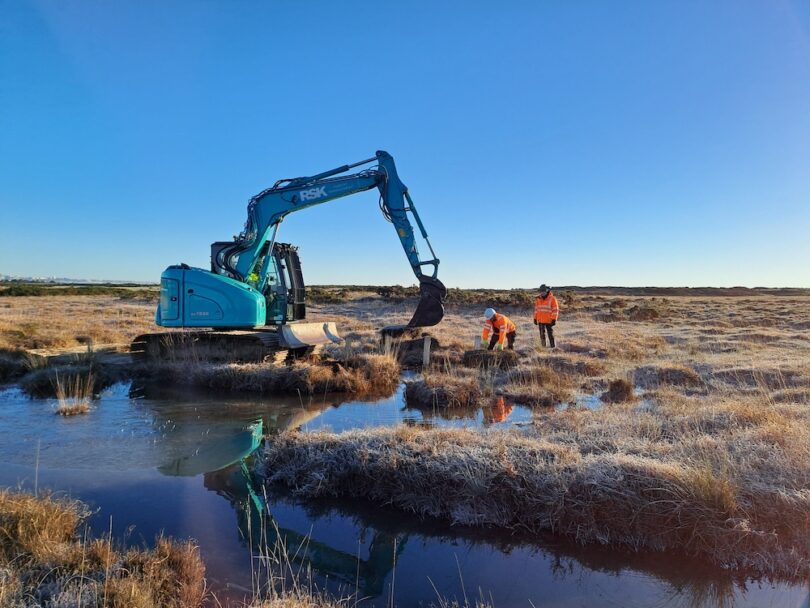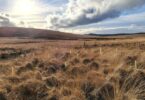A new project has begun at Purbeck Heaths National Nature Reserve to restore 39 hectares of peatland. Starting with recently completed works at Agglestone Mire and Greenlands Mire, the work aims to restore degraded peatland habitat with significant carbon sequestration benefits while helping rare and protected species in the area to thrive.
RSK Habitat Management has embarked on this first phase of restoration in partnership with the Dorset Peat Partnership (DPP), which is a subgroup of the Dorset Catchment Partnerships. This partnership includes Natural England, Dorset Wildlife Trust, the National Trust, Forestry England, the RSPB, Bournemouth, Christchurch and Poole (BCP) Council and a private landowner. The process of restoring the natural peatlands will involve the rewetting of the mires, returning them to their original condition.
RSK Habitat Management Technical Director Jason Winslow said: “Restoring the mires across Purbeck Heaths will have a transformational effect on the landscape. As these peatlands have drained over time, carbon has been gradually released from the ground, and the habitats of many species have shrunk. Not only will a restored peatland environment help the many rare and protected species living in this area to thrive but also it will mean the landscape can once again sequester carbon from the atmosphere.”
The works at Agglestone and Greenlands Mires, covered an area of 12 hectares and applied different techniques to create damming features across the sites. This raised the level of the water table across the mires, restoring the natural hydrological and carbon sequestration processes of the peatland and helping to protect downstream human and wildlife communities from the impacts of increasingly frequent flood events.
Jason said: “The team has applied a range of water blocking techniques so that the dams become features of the environment. Using peat taken from the immediate surrounding area, we installed 52 peat and heather bale dams (achieved by blocking old drainage ditches) and formed eight 50-m-long contour bunds carefully blended into the landscape using the natural topography of the site. The pits were created using a peat ‘borrowing’ technique and shaping the peat into shallow scrapes, which provide additional diversity of habitat. We also created five solid and four leaky timber dams within the mires and placed large woody debris features in wet woodland areas downstream to ‘slow the flow’ of water.”
Working in peat environments presented its own set of challenges, over and above those present in other habitats with Site of Special Scientific Interest (SSSI) status. Jason explained that the team’s specialist equipment needed to be modified to operate in the wet, soft and unstable ground conditions. The undercarriage of the excavator was modified to accommodate wide tracks to make it ultra-low ground pressure, and the machine worked from bog mats to further reduce the risk of damage to the fragile environment. There was also a high risk of discovering unexploded ordnance (UXO), as the area was historically used as a military firing range. UXO specialists undertook advanced scanning and marking of machine access routes and working areas and carried out a watching brief during works.
Jason said: “While delivering peatland restoration has its challenges, the team has been able to find ways of working around them so that the best possible outcome could be delivered for the client. Modifying the plant is one such example. Throughout the works, the site team closely assessed and reviewed proposed works, identifying where improvements could be made to the specification to ensure longevity.
“Initially, locally sourced heather bale dams were proposed as a solution to drainage management; however, these are very much a short-term solution, with a lifespan of 10 years at most. Instead, RSK proposed peat dams and contour bunds as an alternative, permanent solution that would provide rewetting at a landscape scale. These broader interventions will deliver benefits across the whole mire rather than just a small area. We were also able to bring our innovative digital technology capabilities to provide clear comprehensive Power BI reports for the Dorset Peat Partnership, with visual records and precise locations provided for each feature we created for monitoring.”
Works at Agglestone Mire and Greenlands Mire have been completed ahead of schedule, preventing any harm to wildlife through the incoming spring months when birds will begin nesting and the six native reptile species are more active. The peatlands are also home to a multitude of rare and protected species, including the carnivorous Godlingston sundew (Drosera x belezeana), the semi-aquatic raft spider (Dolomedes fimbriatus) and nightjar (Caprimulgus europaeus), which will benefit from these habitat restoration works. The next phase of works to restore further areas of this site will commence in September 2024.
This is the first of a series of planned restoration projects led by the Dorset Peat Partnership that will have a long-lasting legacy for these nationally important peatlands, helping to secure the health of the habitats for wildlife and reversing their degraded ability to act as carbon stores. Jason said: “We have been very excited to work collaboratively with the partnership, contributing our technical knowledge to this hugely important work and providing a digital management platform for use with long-term monitoring.”
Dorset Peat Partnership Project Manager Grace Hervé said: “The strength of this project delivery was evident from day one, with RSK bringing added value to works at Greenlands Mire with the suggestion to use contour bunding to capture and pool more surface water. The team of operatives is highly skilled and left no trace of impact or damage to the habitat. The impact the works have already made to the habitat are striking, and we are really encouraged to see the immediate effects of the site interventions, which are capturing and storing water. We are looking forward to seeing how this site develops in the longer term with both the formation of peat forming habitats and how this will contribute to the wider issues of the climate crisis locally for the Dorset Heaths.”
Other organisations involved with the project are Natural England as project administrator through the Nature for Climate Peatland Grant Scheme; the Department for Environment, Food and Rural Affairs (Defra), which is funding 75% of the project costs; Wytch Farm Landscape and Access Enhancement Fund, Dorset Council and a private donor as additional funders of the Nature for Climate Peatland Grant Scheme; and the Environment Agency, Dorset National Landscape, Bournemouth University and Amphibian and Reptile Conservation Trust, which are providing project support.







